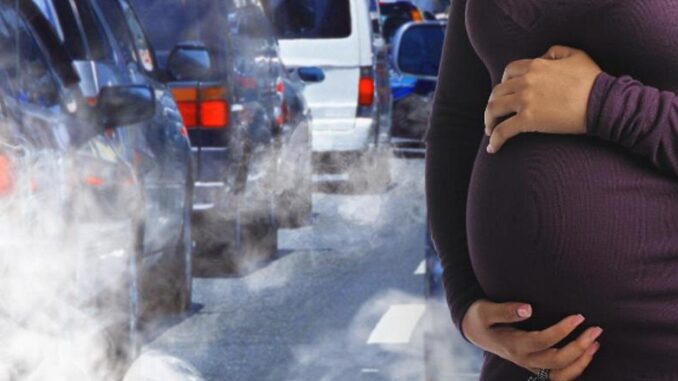
PISCATAWAY, New Jersey, November 15, 2023 (ENS) – From black puffs of diesel exhaust to the sun-blocking haze of orange wildfire smoke, air pollution is known to damage respiratory health. Now, research from Rutgers and four other American universities finds that polluted air can harm human reproductive health. Pollutants from fossil fuel combustion were found to interfere with prenatal hormone activity, affecting “lifelong” reproductive development.
“Together, indoor and outdoor air pollution are estimated to account for deaths worldwide per year, mostly due to respiratory and cardiovascular diseases, including lung cancer, heart disease, stroke, and chronic respiratory illness. Often overlooked is the growing body of evidence suggesting that air pollutants adversely impact reproductive health,” the authors state at the outset of their paper.

In their study of air pollution data in relation to markers of reproductive development in infancy, scientists from Rutgers, the University of Washington, University of Rochester School of Medicine, University of Minnesota, and the Icahn School of Medicine at Mount Sinai Hospital in New York, found certain pollutants negatively alter anogenital distance, a measure of prenatal exposure to hormones.
Anogenital distance, AGD, is the distance from the anus to the base of the penis, and reduction in this length is an indicator of abnormal male reproductive function. Measurement of AGD has been used to indicate impact of potential environmental endocrine disruptors on external genital development. It has been found to be correlated with serum testosterone levels, sperm density, and paternity.
“These findings suggest air pollution may interfere with normal hormone activity during critical periods of prenatal and early infant development, and we suspect that disruption may have long-term consequences for reproductive health,” said Emily Barrett, a professor in the Department of Biostatistics and Epidemiology at the Rutgers School of Public Health and lead author of the study published in the journal “Environmental Health Perspectives.”
Studies in adult men and women have shown that alterations in anogenital distance may be related to hormone levels as well as semen quality, fertility and reproductive disorders.
“Numerous epidemiological studies have reported that exposure to air pollution is associated with reduced semen quality, ovarian reserve, and fecundability. Air pollution exposures during pregnancy, furthermore, have been linked to hypertensive disorders of pregnancy, shortened gestation and preterm birth, and low birthweight and small for gestational age,” the authors write.

“One possible mechanism by which air pollution may impact reproductive health outcomes is through endocrine disruption. Air pollution typically contains complex mixtures of particulate matter (PM) of varying sizes and compositions, including known endocrine disruptors, such as heavy metals and polycyclic aromatic hydrocarbons,” the authors explain in their paper, “Associations of Exposure to Air Pollution during the Male Programming Window and Mini-Puberty with Anogenital Distance and Penile Width at Birth and at 1 Year of Age in the Multicenter U.S. TIDES Cohort.”
In animal studies, anogenital distance is used to determine developmental toxicity of pollutants. One measurable impact is on the reproductive system. When anogenital distance is reduced in male offspring, it’s a sign that a toxic exposure is interfering with fetal testosterone production, Barrett said.
Researchers have speculated that a similar relationship may exist in humans. To test their hypothesis, Barrett and colleagues used data from The Infant Development and Environment Study, TIDES, an ongoing longitudinal study of pregnant women and their children launched in 2010 in four U.S. cities: Minneapolis; Minnesota; Rochester, New York; San Francisco, California; and Seattle, Washington.
Anogenital distance at birth in children, and at one year for boys, was measured as part of the TIDES program.
These data were then compared with levels of nitrogen dioxide and fine particulate matter, called PM2.5, particle pollution 2.5 micrometers or smaller released during the burning of gasoline, oil, diesel and wood.
An air pollution monitoring system administered by the University of Washington tracked pollution levels in the residential areas of TIDES participants during pregnancy.

By comparing these two measures, the researchers identified a link between exposure to air pollution during key developmental windows and anogenital distance.
They found that higher PM2.5 exposure during the so-called male programming window at the end of the first trimester, when the male fetus typically receives a surge of hormones, was associated with shorter anogenital length at birth.
The researchers also observed that higher PM2.5 during mini puberty – a period in early infancy when hormone production is high – was associated with shorter anogenital distance in males at age one.
These findings suggest there may be multiple points during early development that the reproductive system may be vulnerable to the impacts of air pollutants. they concluded.
“PM2.5 is like a trojan horse,” explained Barrett, who said particulate matter can carry metals such as cadmium and lead, known endocrine disruptors. “When these disruptors interfere with the body’s hormones, the result could be lifelong impacts on our health, from cancer risks to impaired ability to conceive a child.”
Featured image: Pregnant woman stands in the midst of air pollution from vehicular traffic. December 2018 (Photo courtesy National Institute of Environmental Health Sciences)



